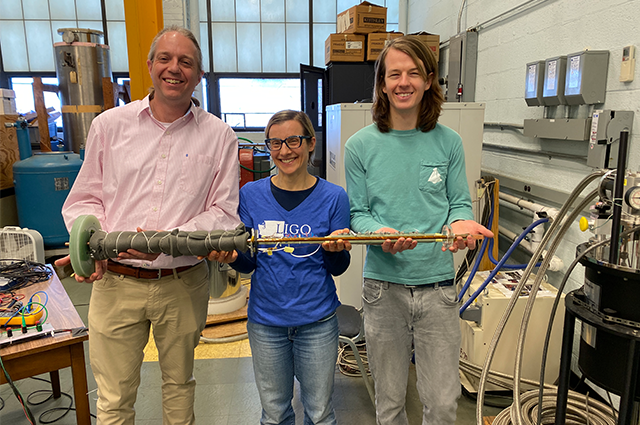Superconductor safety

At Tufts, frequent collaboration among students and faculty leads to fruitful research. Several members of the Department of Mechanical Engineering recently worked together to improve the safety of superconducting cables and magnets. Resistance causes regular conductors to lose energy in the form of heat as the energy moves through the conducting wire. Superconductors take advantage of quantum effects present in specially formulated materials at cryogenic temperatures to eliminate resistance, meaning that they do not dissipate any energy while carrying electric currents. Due to their lack of resistance, superconducting cables and magnets can also handle much higher currents than conventional cables and can be used to create powerful magnetic fields in applications including MRI medical imaging machines, experimental fusion power reactors, and particle accelerators for high energy physics experiments.
Despite the benefits, superconductors also present some drawbacks. For one, they can experience quenching, a sudden local loss of superconductivity in the superconducting magnet or cable. When the material experiences a quench, the superconducting wires rapidly heat up, causing damage to the machine and failure to the system. A group of researchers in the Department of Mechanical Engineering is working to improve quench detection methods using micromachined microphone array sensors.
The group includes mechanical engineering PhD student and first author Peter Moore; Associate Professors Luisa Chiesa and Rob White, both of the Department of Mechanical Engineering; alumni Faris Alquaddoomi, EG22, (also pursuing an MS in innovation and management), Bjorn Isaacson, E22, and Zijia Zhao, EG17 and EG21; and mechanical engineering majors Aidan Beckett, Reid Baris, Jonah D’Alessandro (also pursing an MS in materials science and engineering), Odin Doolittle, Evan Ensslin, and Boning Zhang, all E23, and applied physics major Alden Blackman, A23.
Funded by the U.S. Department of Energy, the group collaborated with researchers at MIT and Tanner Research to develop micro electro-mechanical system (MEMS) acoustic sensor arrays to detect quench events. When the team replaced the application specific integrated circuit (ASIC) in the device with a custom preamplifier that can operate in cryogenic temperatures, the MEMS microphones were able to record sound in the cryogenic coolant inside superconducting cables and magnets. Its reliance on fast traveling soundwaves to detect quench events means that it can detect a quench quickly, and also determine the specific location of a quench event, compared to other methods.
Quench detection is “an important safety requirement for the operation of high field magnets for such applications as fusion energy and high energy physics, as well as operation of superconducting cables for low loss energy transmission,” says White. The group is likely one of the first to record sound within the cryogenic coolant near a superconducting tape. The paper on the team’s research, titled "Acoustic sensor development for quench detection in HTS conductors for fusion applications," appeared in the journal IEEE Transactions on Applied Superconductivity and presents the promising results obtained so far. More research will be needed to fully explore the potential of this approach to quench detection.
Chiesa’s primary research area is superconducting materials for energy application. Her current research focus is the electro-mechanical behavior of superconducting materials for large magnets used in fusion power devices. White is the director of the Microscale Sensors and Systems Lab and a faculty advisor to the Tufts Micro and Nano Fabrication Facility, and works on sensor systems. Collaborative environments like the one fostered by Chiesa and White create a mutually beneficial learning environment for all at Tufts School of Engineering. Undergraduate students benefit from the expertise of graduate students and faculty members, while MS and PhD students have a chance to informally mentor younger students while developing their own skills at a higher level, and students of all levels help faculty further groundbreaking research. Chiesa, White, and faculty members across the School of Engineering continue to advance excellence in research through collaborative lab environments.
Department:
Mechanical Engineering